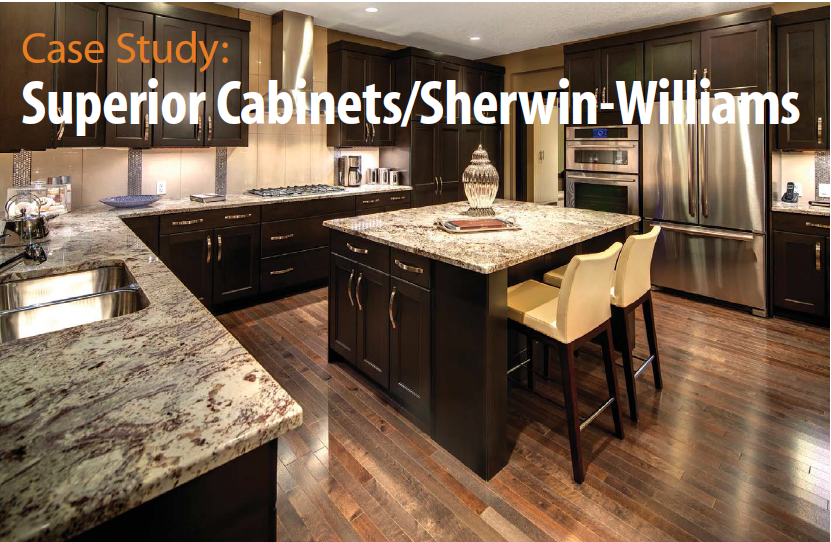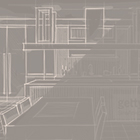This article, Canadian Finishing & Coating Manufacturing Case Study: Superior Cabinets/Sherwin-Williams, was featured in the March/April 2014 edition of the CFCM – Canadian Finishing & Coatings Manufacturing Magazine.
Superior Cabinets of Saskatoon, Saskatchewan is a privately owned manufacturer of custom kitchen cabinets and serves both builders and consumers from five company-owned showrooms throughout Saskatchewan and Alberta. Superior also sells through a network of approximately 75 dealers in the two provinces. In business for more than 30 years, Superior embarked on a business improvement project in 2008 to reduce cost, improve efficiency and increase its sustainability related initiatives. As part of the effort, Superior looked at ways to improve its purchasing and ultimately determined that its supplier relationships needed to be more than “just buying something over the counter. ”Superior’s desire was to form strategic partnerships in which suppliers could provide suggestions for overall process improvements in their respective field of expertise. Working as partners with their vendors, Superior would develop annual plans to accomplish agreed upon goals with a target of an overall three percent cost reduction per year. One of the core purchasing categories to be reviewed involved coating products. Superior sought to develop a partnership with a supplier that could provide overall coating line improvements and help the company meet sustainability goals in addition to cost savings. Of several potential suppliers reviewed, Superior selected Sherwin-Williams to supply technical expertise in addition to more than 85 finishes, including conversion varnishes, spray stains, glazes and sealers.
HITTING THE GROUND RUNNING
With a primary goal of the partnership being to improve processes by increasing throughput while maintaining quality but shrinking costs, Sherwin-Williams kicked off its work with Superior with the development of a technical support program. There was a review of Superior’s coating lines, which comprise three finishing work centers – an automated flat line with six colour changers that apply stains and clear coats; a conversion varnish/paint work center in which colour selection, mixing and spraying is automated while the line is loaded and unloaded manually; and a manual spray/specialty finishes area in which specialty cabinets are finished by hand through spraying, glazing and wipe staining. Plant Manager Brent Boechler oversees a Monday through Friday two shift finishing operation responsible for finishing four cabinet product lines. The cabinets are constructed of a variety of materials that includes five natural wood species, medium-density fiberboard (MDF) and other substrates. He believes the establishment of a technical support program was a significant first accomplishment for Sherwin-Williams. “We have a Sherwin-Williams technical representative assigned to our account who spends two days a week in our plant reviewing processes to ensure that everything is running properly,” Boechler said. “He works directly with our 45 employees, and together they develop ideas about how to improve coating line processes such as stain formulations or sanding processes. The rep makes proposals to the maintenance manager or electrician, and they streamline operations.” “When the primary representative isn’t available, Sherwin-Williams provides another technical representative who may have a different skill set – more of an equipment expert than a coatings expert, for example,” Boechler added. “That brings in a fresh set of eyes. They’re all helpful. In one instance, the rep established a baseline for the transfer efficiency at our lacquer finishing work center. The tools he developed allow us to regularly measure transfer efficiency and make adjustments accordingly to achieve consistency and reduce costs. That’s not something we could have done on our own.”
A SUSTAINABLE PARTNERSHIP
One of Superior Cabinets’ operating tenets is a commitment to the environment. Because the company relies on the forest industry to provide premium wood products for its cabinets, it makes a point of ensuring that all of its operations are performed in tandem with minimizing environmental impact and replenishing resources. The commitment to sustainability is another area in which Superior’s partnership with Sherwin-Williams has succeeded. Two examples include a catalyzed conversion varnish mixing operation and the creation of a program to clean and recycle finishing line solvents instead of disposing of the solvents as hazardous waste. Both solutions employ a complete finishing solution program offered by Sherwin-Williams called ProVisions – a collaboration between the coatings manufacturer and select equipment and components suppliers with the goal of solving customer coatings line issues through teamwork. “The catalyzed conversion varnish mixing operation involved products that were mixed by hand,” said Boechler. “Everything was dialed in manually but that left us at risk for human error as well as the potential for waste. Once the materials are catalyzed, the clock begins to tick; if you don’t use the finish in a certain amount of time, it becomes waste. When we offered only four or five colours, it wasn’t that big of a deal, but when we started using 10 colours in a single shift, we found ourselves wasting gallons of coatings as well as hundreds of dollars a day.” Sherwin-Williams studied the mixing operation and returned with a solution developed by its design engineering team and ProVisions partner Kremlin. The program, which was implemented in June 2013, utilizes a Kremlin plural component mixing system that allows the finish to be mixed at the spray gun instead of in batches. The system uses less finish; only what is needed is sprayed, eliminating waste in terms of both product and dollars. In addition, 20 gallons of solvent had been required at the end of a shift to flush the system; that has been reduced by 75 percent, another savings of both material and cost. The solvent cleaning and recycling program began in 2011. It replaced an in-house effort focused on recycling the solvents used to clean and flush the finishing lines.
“That’s not our core competency,” said Boechler. “Sherwin-Williams and its ProVisions partner Nexeo developed a program that resulted in a closed loop system where all the waste solvents are picked up once a week from the manufacturing facility, cleaned and filtered and sold back to Superior. It’s been fantastic. It’s not only good for the environment – we estimate that it saved us $75,000 in disposal fees in the first year. Plus we reclaimed valuable manufacturing floor space when we stopped trying to do the process alone. Our responsibility now is to make sure that the proper solvents go into the proper barrels.”
TEAMING UP TO LAUNCH NEW PRODUCTS
When manufacturing countertops and tabletops from MDF for some of its retail locations, Superior experimented with a finish that included stain, a clear coat, and a chalk coat followed by sanding. The result was a wood grain appearance that looked great. The company thought: “Why not offer an affordable cabinet with recycled material that has a terrific look?” The challenge: achieving a consistent finish on a substrate not known for its ability to be stained. “We call it our Fusion line of cabinets, and it’s unique,” said Boechler. “The MDF is a recycled product, which makes it a sustainable product – but you’re not supposed to be able to stain MDF. We found that the process we devised actually gave us the look of a five-piece cabinet door. But we wanted to make sure we could keep the finish consistent. We’re not coating experts, and our initial chalk supplier couldn’t keep up with the demand. Sherwin- Williams stepped in and developed a chalk to work for the new finish. They changed the formula a bit to make it more of a standard operating procedure for us and to ensure that the finish had a good life span.” Superior’s marketing department and the Sherwin-Williams Global Color and Design Center also conduct an annual colour palette assessment to ensure that the finishes offered on the cabinet lines remain current with market trends. The annual reviews have helped Superior refine its colour offering.
KEEPING SCORE
Measuring success is a key part of Superior Cabinets partnership program with Sherwin-Williams and all other suppliers. The company keeps “score cards” on all significant initiatives agreed upon at the beginning of each year. Quarterly meetings between the two companies ensure that program initiatives and cost reduction goals are being met. In the coating area, Boechler said that Superior is getting something today that the company didn’t have in the past: a resource that they can depend on beyond just the coating products. “It’s a good fit both culturally and economically,” he said. “We have a 99 percent fill rate; very few gallons are delivered that are non-conforming. On time delivery is in the mid-90 percentile. They supply us with 85 different finishes, help us with our processes, help us keep track of atmospheric conditions in the plant – and then, keeping the finish consistent. No two trees are the same. Consistency requires some maintenance, and they can help us reformulate slightly to keep us production ready.” “We were impressed with what they brought to the table five years ago, and they have more than filled their side of the agreement,” he said. “They’re not as well known in western Canada, but they’re a rock solid company with which to work and they’ve filled their end of the agreement.”
This article, Canadian Finishing & Coatings Manufacturing Case Study: Superior Cabinets/Sherwin-Williams, was featured in the March/April 2014 edition of the CFCM – Canadian Finishing and Coatings Manufacturing Magazine

